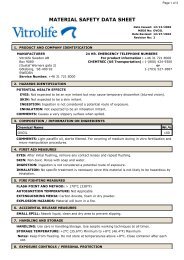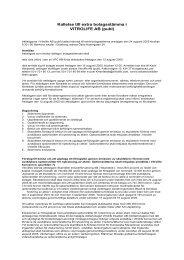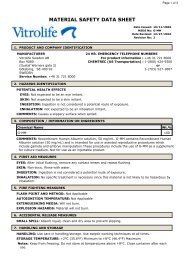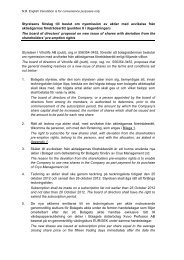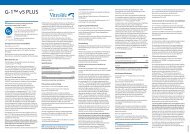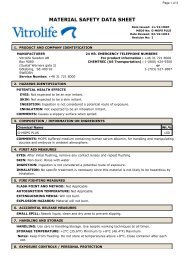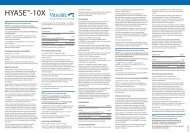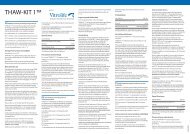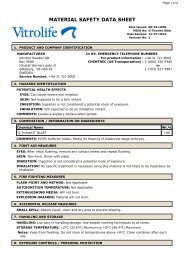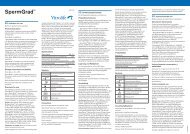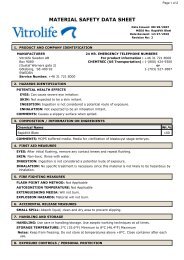Rapid-i Kit_26134-05 dr4.indd - Vitrolife
Rapid-i Kit_26134-05 dr4.indd - Vitrolife
Rapid-i Kit_26134-05 dr4.indd - Vitrolife
Create successful ePaper yourself
Turn your PDF publications into a flip-book with our unique Google optimized e-Paper software.
<strong>Rapid</strong>-i <strong>Kit</strong><br />
EN: Instructions for use – <strong>Rapid</strong>-i <strong>Kit</strong><br />
Product Description<br />
<strong>Rapid</strong>-i <strong>Kit</strong> is a cryopreservation device<br />
intended to be used to contain, vitrify and<br />
maintain embryos and/or oocytes. In the US –<br />
for 4-8 cell stage embryos only.<br />
<strong>Rapid</strong>-i <strong>Kit</strong> consists of the following three items:<br />
• 80 mm PMMA stick (<strong>Rapid</strong>-i)<br />
• 135 mm Mediprene straw equipped with a<br />
stainless steel weight, (<strong>Rapid</strong>Straw)<br />
• 115 mm stainless steel rod inserted in the<br />
<strong>Rapid</strong>Straw<br />
Storage Instructions<br />
Store at room temperature.<br />
Discard device after completion of procedure.<br />
Directions for use<br />
Vitrification may only be performed by staff<br />
trained in vitrification procedures. Preparation<br />
of the embryos for vitrification has to be<br />
accurate and according to the instructions<br />
provided with the vitrification media.<br />
The following equipment and material are<br />
needed in addition to the <strong>Rapid</strong>-i <strong>Kit</strong> device:<br />
• SmartBox and lid from <strong>Vitrolife</strong>, the lid works<br />
as a <strong>Rapid</strong>Straw holder during vitrification and<br />
warming<br />
• A stereo microscope with a heated stage<br />
• Ultrasonic sealer<br />
• Needle nose tweezers<br />
• <strong>Rapid</strong>-i Cutter<br />
• Labels with patient identification intended for<br />
storage in liquid nitrogen or cryomarker pen<br />
• Liquid nitrogen<br />
• Cryocane with goblet and appropriate<br />
storage vessel or equivalent equipment<br />
• Micropipettes for manipulating embryos<br />
Read all of the instructions below before<br />
opening the package.<br />
Vitrification<br />
Plan for transfer of the <strong>Rapid</strong>-i to and from<br />
the long term storage without leaving liquid<br />
nitrogen in advance, prior to starting the<br />
procedure.<br />
Place the Ultrasonic sealer on the lab bench<br />
and turn it on.<br />
<strong>26134</strong>.<strong>05</strong><br />
Place the SmartBox on the lab bench close to<br />
the microscope. Ensure the bench used for the<br />
procedure can tolerate liquid nitrogen spills.<br />
Fill the SmartBox with liquid nitrogen up to 1<br />
cm from the box’s rim and place the lid on top<br />
of the box. The minimum distance between the<br />
surface of the liquid nitrogen and the top of<br />
the <strong>Rapid</strong>Straw is 55 mm. Always keep the top<br />
of the <strong>Rapid</strong>Straw at a sufficient distance from<br />
the liquid nitrogen.<br />
NOTE: Always maintain a sufficient level of liquid<br />
nitrogen in the SmartBox.<br />
Prepare the dishes with vitrification media<br />
according to the instructions provided with<br />
the media. Place the dishes close to the<br />
microscope.<br />
Check that the <strong>Rapid</strong>-i <strong>Kit</strong> packaging is intact<br />
and that the use by date has not expired. Open<br />
the package using aseptic technique.<br />
Label the exact number of <strong>Rapid</strong>Straws needed<br />
with the patient’s identification or according to<br />
local regulations. Place the label below the top,<br />
black mark of the <strong>Rapid</strong>Straw.<br />
Prepare 1-5 embryos for vitrification by<br />
following the instructions provided with the<br />
vitrification media.<br />
After moving the embryos to Vitrification<br />
solution 2, place the <strong>Rapid</strong>Straw with metal rod<br />
in the SmartBox to cool down. Remove the<br />
metal rod 20-30 seconds before insertion of<br />
the <strong>Rapid</strong>-i into the <strong>Rapid</strong>Straw.<br />
Place the <strong>Rapid</strong>-i on the microscope stage<br />
with the flat side down. Locate the correct<br />
plane of focus so that the hole of the <strong>Rapid</strong>-i<br />
is in view, for easy loading.<br />
Collect the embryos with a <strong>Vitrolife</strong><br />
micropipette.<br />
Slide the hole of the <strong>Rapid</strong>-i into view, in the<br />
microscope. Move the tip of the pipette close<br />
to the wall of the hole in the <strong>Rapid</strong>-i and<br />
apply slight pressure to expel the embryos<br />
into the hole. The maximum volume of the<br />
vitrification solution should not exceed the<br />
volume of the hole (30 nL).<br />
NOTE: Avoid overfilling the hole or else the<br />
embryos may float out.<br />
Slide the <strong>Rapid</strong>-i off the microscope stage<br />
and quickly, but carefully, place it vertically<br />
into the pre-cooled <strong>Rapid</strong>Straw sitting in the<br />
SmartBox. Cover the hole immediately after<br />
insertion for a few seconds to prevent that<br />
the <strong>Rapid</strong>-i accidentally pops out. Make sure<br />
that no more than 8-12 mm of the <strong>Rapid</strong>-i is<br />
visible above the lid when fully inserted. The<br />
embryos are now vitrified and should not be<br />
warmed again until the warming procedure<br />
is planned.<br />
WARNING: From this point, inappropriate<br />
handling of the sealed <strong>Rapid</strong>Straw may cause<br />
warming which can lead to de-vitrification of<br />
the embryos. The sealed <strong>Rapid</strong>Straw may not be<br />
removed from liquid nitrogen.<br />
Seal the top of the <strong>Rapid</strong>Straw using the<br />
Ultrasonic sealer. Inspect the seal to ensure<br />
that sealing was correctly performed. Make<br />
sure that the seal covers the entire diameter<br />
of the <strong>Rapid</strong>Straw and that no holes or defects<br />
are present. If appropriate sealing has not<br />
occurred, attempt to reseal the <strong>Rapid</strong>Straw.<br />
Place the storage vessel (e.g. cryocane with<br />
attached goblet) into the SmartBox.<br />
Move the sealed <strong>Rapid</strong>Straw from the lid and<br />
into the goblet, so that the <strong>Rapid</strong>Straw with the<br />
embryos does not leave the liquid nitrogen.<br />
The lowest black mark of the <strong>Rapid</strong>Straw must<br />
always be immersed in liquid nitrogen.<br />
Warming<br />
Place the SmartBox on the lab bench close to<br />
the microscope. Ensure the bench used for the<br />
procedure can tolerate liquid nitrogen spills.<br />
Fill the SmartBox with liquid nitrogen up to 1<br />
cm from the box’s rim and place the lid on top<br />
of the SmartBox.<br />
Prepare the dishes with warming media<br />
according to the instructions provided with<br />
the media. Place the dishes close to the<br />
microscope.<br />
Move the cryocane and goblet containing the<br />
<strong>Rapid</strong>Straws into the liquid nitrogen in the<br />
SmartBox. Remove one <strong>Rapid</strong>Straw, without<br />
leaving the liquid nitrogen and make sure<br />
that the <strong>Rapid</strong>Straw is secure in the lid and<br />
that the lower end touches the bottom of the<br />
SmartBox.<br />
Warm the <strong>Rapid</strong>Straw with your fingers around<br />
the black mark to get a better view of the black<br />
tab on the <strong>Rapid</strong>-i. Hold the <strong>Rapid</strong>Straw well<br />
above the black mark and cut it 3 mm above<br />
the back end of the <strong>Rapid</strong>-i. Do not lift the<br />
<strong>Rapid</strong>Straw from the lid and make sure it stays<br />
up-right in liquid nitrogen.<br />
Lift the <strong>Rapid</strong>-i (using needle nose tweezers)<br />
out of the <strong>Rapid</strong>Straw just enough to enable<br />
you to grasp the end with your finger tips.<br />
Then quickly (as fast as possible, preferably<br />
less than 2 seconds), but carefully, remove the<br />
<strong>Rapid</strong>-i from the <strong>Rapid</strong>Straw and plunge<br />
the tip and hole of the <strong>Rapid</strong>-i into the<br />
first warming solution immediately. While<br />
watching under the microscope, gently move<br />
the <strong>Rapid</strong>-i back and forth. Verify that the<br />
embryos are free in the warming media and<br />
then remove the <strong>Rapid</strong>-i.<br />
Proceed with the warming according to the<br />
instructions provided with the warming media.<br />
Discard the <strong>Rapid</strong>-i <strong>Kit</strong> and <strong>Rapid</strong>Straw<br />
according to lab routines.<br />
Precautions<br />
The responsibility for correct clinical use and<br />
technique rests with the user. It is important<br />
that the user be trained in vitrification<br />
procedures and adheres to these instructions<br />
for best results. The directions below are<br />
provided as a suggestion for procedure.<br />
The user must be trained in vitrification<br />
procedures and evaluate the suitability of<br />
this procedure in her/his lab. Labelling of<br />
the straw and transfer to and from long term<br />
storage without leaving liquid nitrogen must<br />
be planned in advance, prior to starting the<br />
procedure.<br />
<strong>Rapid</strong>-i and the <strong>Rapid</strong>Straw are intended<br />
for single use only and MAY NOT BE REUSED.<br />
Re-use may cause contamination, poor<br />
embryo survival and failed procedure.<br />
Do not use the product if the sterile pouch, or<br />
any contents, are damaged.<br />
To preserve sterility, <strong>Vitrolife</strong> recommends that<br />
the <strong>Rapid</strong>-i <strong>Kit</strong> is opened and used only with<br />
aseptic technique.<br />
Use safety pre-cautions when working with<br />
liquid nitrogen, including wearing protective<br />
gear such as cryo-gloves, goggles, close-toed<br />
shoes and an apron in a well-ventilated room.<br />
Caution: Federal (US) law restricts this device<br />
to sale by or on the order of a physician.<br />
Specifications<br />
A<br />
B<br />
(C)<br />
ONLY<br />
RX ONLY<br />
Rx ONLY<br />
ONLY<br />
Sterilized<br />
(D)<br />
using ethylene oxide.<br />
RX ONLY ONLY<br />
MEA (1-cell, expanded A blastocyst Rx on ONLY day 5) ≥ ONLY<br />
ONLY 80 %..<br />
B<br />
RX ONLY<br />
Bacterial Endotoxins (LAL A assay) ≤ 1.0 EU/device. RX ONLY<br />
RX ONLY<br />
(C)<br />
Rx ONLY<br />
A<br />
Rx ONLY<br />
Store at room temperature Rx ONLY<br />
(D) B<br />
B<br />
Do not re-use, (C) discard after procedure.<br />
(C)<br />
Use by – see (C)<br />
(D)<br />
(D)<br />
label.<br />
Caution: Consult (D) accompanying documents.<br />
Catalog number<br />
Batch code.<br />
The cooling rate at -50 °C is -1400 °C/minute<br />
and the corresponding warming rate is 10,000<br />
°C/minute.<br />
ONLY<br />
RX ONLY<br />
DE: Anwendungsanleitung A<br />
– <strong>Rapid</strong>-i Rx ONLY<br />
<strong>Kit</strong><br />
Produktbeschreibung B<br />
<strong>Rapid</strong>-i <strong>Kit</strong> ist ein (C)<br />
Gerät zur<br />
Kryokonservierung und dient der Verwahrung<br />
(D)<br />
und Vitrifizierung von Embryonen und/oder<br />
Oozyten. In den USA – nur für Embryonen<br />
zwischen dem 4ten und 8ten Zellstadium.<br />
<strong>Rapid</strong>-i <strong>Kit</strong> besteht aus folgenden drei<br />
Komponenten:<br />
• 80 mm PMMA-Stäbchen (<strong>Rapid</strong>-i)<br />
• 135 mm Mediprene-Röhrchen mit einem<br />
Gewicht aus rostfreiem Stahl, (<strong>Rapid</strong>Straw).<br />
• 115 mm langer Stab aus rostfreiem Stahl im<br />
<strong>Rapid</strong>Straw<br />
Lagerungsanweisungen<br />
Bei Zimmertemperatur lagern.<br />
Gerät nach Abschluss der Prozedur entsorgen.<br />
Gebrauchsanleitung<br />
Die Vitrifikation darf nur von Personal<br />
durchgeführt werden, das hierfür ausgebildet<br />
ist. Die Vorbereitung der Embryonen für die<br />
Vitrifizierung muss äußerst sorgfältig und<br />
gemäß der Gebrauchsanleitung für das<br />
Vitrifizierungsmedium erfolgen.<br />
Zusätzlich zu <strong>Rapid</strong>-i <strong>Kit</strong> sind die folgenden<br />
Gegenstände und Materialien erforderlich:<br />
• SmartBox mit Deckel von <strong>Vitrolife</strong>; der<br />
Deckel dient während der Vitrifizierung und<br />
beim Aufwärmen als <strong>Rapid</strong>Strawhalterung.<br />
• Ein Stereomikroskop mit vorgewärmtem<br />
Objektträger<br />
• Ultraschallversiegler<br />
• Präzisionspinzette<br />
• <strong>Rapid</strong>-i Cutter<br />
• Eine für die Lagerung in Flüssigstickstoff<br />
geeignetes Etikett mit Patienten-ID oder ein<br />
Kryostift<br />
• Flüssigstickstoff<br />
• Kryobehälter mit Becher und geeignetes<br />
Lagergefäß oder ähnliche Ausrüstung<br />
• Mikropipetten zur Manipulation der<br />
Embryonen<br />
Lesen Sie sich vor dem Öffnen der Verpackung<br />
die Gebrauchsanweisung sorgfältig durch.<br />
Vitrifikation<br />
Planen Sie vor Beginn der Prozedur den<br />
Transfer von <strong>Rapid</strong>-i in und aus dem<br />
Langzeitlagerbehältnis so, dass immer unter<br />
Flüssigstickstoff gearbeitet wird.<br />
Platzieren Sie den Ultraschallversiegler auf<br />
der Laborarbeitsfläche und schalten Sie das<br />
Gerät ein.<br />
Platzieren Sie die SmartBox auf der<br />
Laborarbeitsfläche in der Nähe des Mikroskops.<br />
Stellen Sie sicher, dass die für die Prozedur<br />
genutzte Laborarbeitsfläche resistent gegen<br />
Schäden durch Flüssigstickstoff ist.<br />
Füllen Sie die SmartBox bis auf 1 cm<br />
unterhalb der Behälterkante mit<br />
Flüssigstickstoff und platzieren Sie<br />
anschließend den Deckel auf dem Behälter.<br />
Der Mindestabstand zwischen der<br />
Flüssigstickstoffoberfläche und dem oberen<br />
Ende des <strong>Rapid</strong>Straws beträgt 55 mm.<br />
Stellen Sie sicher, dass das obere Ende des<br />
<strong>Rapid</strong>Straws stets ausreichend Abstand zum<br />
Flüssigstickstoff hat.<br />
HINWEIS: Sorgen Sie dafür, dass stets ausreichend<br />
Flüssigstickstoff in der SmartBox enthalten ist.<br />
Bereiten Sie die Schalen mit dem<br />
Vitrifizierungsmedium gemäß der<br />
Gebrauchsanleitung für dieses Medium vor.<br />
Platzieren Sie die Schalen in der Nähe des<br />
Mikroskops.<br />
Stellen Sie sicher, dass die Verpackung<br />
des <strong>Rapid</strong>-i <strong>Kit</strong> unbeschädigt und das<br />
Verfallsdatum noch nicht abgelaufen ist.<br />
Öffnen Sie die Verpackung unter Anwendung<br />
einer aseptischen Technik.<br />
Beschriften Sie die erforderliche Anzahl<br />
<strong>Rapid</strong>Straw mit der ID des Patienten oder<br />
gemäß den lokal geltenden Vorschriften.<br />
Kleben Sie die Etiketten unterhalb der<br />
schwarzen Markierung auf das <strong>Rapid</strong>Straw.<br />
Bereiten Sie 1 bis 5 Embryonen gemäß<br />
der Gebrauchsanweisung für das<br />
Vitrifizierungsmedium für die Vitrifizierung vor.<br />
Nachdem Sie die Embryonen in die<br />
Vitrifikationslösung 2 überführt haben, stellen<br />
Sie den <strong>Rapid</strong>Straw mit Metallstab zum<br />
vorkühlen in die SmartBox. Entfernen Sie<br />
den Metallstab 20-30 Sekunden bevor Sie das<br />
<strong>Rapid</strong>-i in den Straw einführen.<br />
Platzieren Sie <strong>Rapid</strong>-i mit der flachen<br />
Seite nach unten auf dem Objektträger<br />
des Mikroskops. Stellen Sie die richtige<br />
Fokussierungsebene ein, sodass <strong>Rapid</strong>-i<br />
vollständig im Sichtfeld ist und das Laden so<br />
erleichtert wird.<br />
Entnehmen Sie die Embryonen mit einer<br />
Mikropipette von <strong>Vitrolife</strong>.<br />
Platzieren Sie <strong>Rapid</strong>-i vollständig im<br />
Sichtbereich des Mikroskops. Platzieren Sie<br />
die Pipettenspitze am Rand der Öffnung des<br />
<strong>Rapid</strong>-i und üben Sie leichten Druck aus, um<br />
die Embryonen in die Öffnung zu geben. Das<br />
Höchstvolumen der Vitrifizierungslösung darf<br />
das Fassungsvermögen der Öffnung (30 nL)<br />
nicht überschreiten.<br />
HINWEIS: Die Öffnung darf nicht überfüllt werden,<br />
da die Embryonen sonst ausgeschwemmt werden<br />
können.<br />
Nehmen Sie das <strong>Rapid</strong>-i vom Objektträger<br />
und geben Sie es schnell aber vorsichtig<br />
vertikal in das vorgekühlte <strong>Rapid</strong>Straw<br />
in der SmartBox. Decken Sie das Ganze<br />
anschließend einige Sekunden lang ab, um zu<br />
verhindern, dass das <strong>Rapid</strong>-i versehentlich<br />
wieder hinausgleitet. Stellen Sie sicher, dass<br />
nach dem vollständigen Einführen nicht<br />
mehr als 8 bis 12 mm des <strong>Rapid</strong>-i über den<br />
Deckel hinausragen. Die Embryonen sind nun<br />
vitrifiziert und sollten bis zu einer geplanten<br />
Aufwärmprozedur nicht aufgewärmt werden.<br />
WARNUNG: Ab diesem Moment kann eine<br />
unsachgemäße Handhabung des versiegelten<br />
<strong>Rapid</strong>Straws zum Aufwärmen und damit zur<br />
Entvitrifizierung der Embryonen führen. Das<br />
versiegelte <strong>Rapid</strong>Straw darf nicht aus dem<br />
Flüssigstickstoff entnommen werden.<br />
Versiegeln Sie das obere Ende des <strong>Rapid</strong>Straws<br />
mithilfe des Ultraschallversiegler. Überprüfen<br />
Sie die Versiegelung und stellen Sie sicher,<br />
dass der Vorgang fehlerfrei durchgeführt<br />
wurde. Stellen Sie ebenfalls sicher, dass die<br />
Versiegelung über den gesamten Durchmesser<br />
des <strong>Rapid</strong>Straws reicht und keine Löcher oder<br />
anderen Beschädigungen aufweist. Wenn die<br />
Versiegelung mangelhaft ist, versiegeln Sie das<br />
<strong>Rapid</strong>Straw erneut.<br />
Platzieren Sie das Lagerbehältnis (d. h.<br />
Kryobehälter mit Becher) in der SmartBox.<br />
Nehmen Sie das versiegelte <strong>Rapid</strong>Straw<br />
aus dem Deckel und geben Sie es in den<br />
Becher, sodass es mit den Embryonen im<br />
Flüssigstickstoff verbleibt. Die unterste<br />
schwarze Markierung auf dem <strong>Rapid</strong>Straw<br />
muss sich stets im Flüssigstickstoff befinden.<br />
Erwärmen<br />
Platzieren Sie die SmartBox auf der<br />
Laborarbeitsfläche in der Nähe des Mikroskops.<br />
Stellen Sie sicher, dass die für die Prozedur<br />
genutzte Laborarbeitsfläche resistent gegen<br />
Schäden durch Flüssigstickstoff ist.<br />
Füllen Sie die SmartBox bis auf 1<br />
cm unterhalb der Behälterkante mit<br />
Flüssigstickstoff und platzieren Sie<br />
anschließend den Deckel auf dem Behälter.<br />
Bereiten Sie die Schalen mit dem<br />
Erwärmungsmedium gemäß der<br />
Gebrauchsanweisung für dieses Medium vor.<br />
Platzieren Sie die Schalen in der Nähe des<br />
Mikroskops.<br />
Geben Sie den Kryobehälter und den Becher<br />
mit den <strong>Rapid</strong>Straw in den Flüssigstickstoff in<br />
der SmartBox. Entnehmen Sie ein <strong>Rapid</strong>Straw<br />
so, dass es im Flüssigstickstoff verbleibt, und<br />
stellen Sie sicher, dass das <strong>Rapid</strong>Straw sicher im<br />
Deckel sitzt und das untere Ende den Boden<br />
der SmartBoxs berührt.<br />
Erwärmen Sie das <strong>Rapid</strong>Straw mit Ihren<br />
Fingern im Bereich der schwarzen Markierung,<br />
um das schwarze Etikett auf dem <strong>Rapid</strong>-i<br />
besser lesen zu können. Halten Sie das<br />
<strong>Rapid</strong>Straw oberhalb der schwarzen<br />
Markierung fest und schneiden Sie es 3 mm<br />
oberhalb des hinteren Endes des <strong>Rapid</strong>-i<br />
ab. Heben Sie das <strong>Rapid</strong>Straw nicht aus dem<br />
Deckel und stellen Sie sicher, dass es im<br />
Flüssigstickstoff aufrecht stehen bleibt.<br />
Heben Sie <strong>Rapid</strong>-i (mit Hilfe einer<br />
Präzisionspinzette) so weit aus dem<br />
<strong>Rapid</strong>Straw, dass Sie das Ende mit Ihren<br />
Fingerspitzen greifen können. Entnehmen<br />
Sie <strong>Rapid</strong>-i schnell aber vorsichtig (so<br />
schnell wie möglich, möglichst schneller als 2<br />
Sekunden) aus dem <strong>Rapid</strong>Straw, und geben<br />
Sie die Spitze und die Öffnung von <strong>Rapid</strong>-i<br />
umgehend in die erste Erwärmungslösung.<br />
Beobachten Sie unter dem Mikroskop, wie<br />
Sie <strong>Rapid</strong>-i vorsichtig vor und zurück<br />
bewegen. Überprüfen Sie, ob die Embryonen<br />
frei im Erwärmungsmedium schwimmen, und<br />
entfernen Sie dann das <strong>Rapid</strong>-i.<br />
Fahren Sie mit der Erwärmung gemäß<br />
der Gebrauchsanweisung für das<br />
Erwärmungsmedium fort.<br />
Entsorgen Sie <strong>Rapid</strong>-i <strong>Kit</strong> und das <strong>Rapid</strong>Straw<br />
gemäß den geltenden Laborrichtlinien.<br />
Vorsichtsmaßnahmen<br />
Die Verantwortung für den korrekten<br />
klinischen Gebrauch und die richtige<br />
Technik liegt beim Anwender. Der Anwender<br />
muss mit Vitrifizierungsprozeduren<br />
vertraut sein und die entsprechenden<br />
Gebrauchsanweisungen genau einhalten,<br />
um das beste Ergebnis zu erzielen. Die<br />
folgenden Gebrauchsanweisungen dienen als<br />
Empfehlung für die Prozedur. Der Anwender<br />
muss mit Vitrifizierungsprozeduren vertraut<br />
sein und die Eignung dieser Prozedur in<br />
seinem Labor evaluieren. Die Etikettierung<br />
des <strong>Rapid</strong>Straws und der Transfer in und aus<br />
der Langzeitlagerung ohne Verlassen des<br />
Flüssigstickstoffs müssen im Voraus geplant<br />
sein.<br />
<strong>Rapid</strong>-i ist für den Einmalgebrauch bestimmt<br />
und DARF NICHT WIEDERVERWENDET<br />
WERDEN. Eine Wiederverwendung kann eine<br />
Kontaminierung verursachen, das Überleben<br />
der Embryonen gefährden oder die Prozedur<br />
scheitern lassen.<br />
Verwenden Sie das Produkt nicht, wenn der<br />
sterile Beutel oder der Inhalt beschädigt sind.<br />
Um Sterilität zu gewährleisten, empfiehlt<br />
<strong>Vitrolife</strong>, <strong>Rapid</strong>-i <strong>Kit</strong> nur unter Anwendung<br />
aseptischer Techniken zu öffnen und zu<br />
verwenden.<br />
Arbeiten Sie nur unter Anwendung von<br />
geeigneten Sicherheitsmaßnahmen mit<br />
Flüssigstickstoff und tragen Sie Schutzkleidung<br />
wie Kryo-Handschuhe, Schutzbrille,<br />
geschlossene Schuhe und eine Schürze; der<br />
Raum muss gut gelüftet sein.<br />
Hinweis: Nach US-amerikanischem Gesetz darf<br />
dieses Produkt nur von einem Arzt gekauft<br />
oder gegen Vorlage eines ärztlichen Rezeptes<br />
verkauft werden.<br />
Produktdaten<br />
A<br />
B<br />
(C)<br />
ONLY<br />
RX ONLY<br />
Rx ONLY<br />
ONLY<br />
Durch Ethylenoxid (D) sterilisiert.<br />
RX ONLY<br />
A<br />
Einzelliger MEA ≥ 80 % erweiterte Rx Blastozysten ONLY ONLY<br />
ONLY<br />
an Tag 5.<br />
B<br />
Bakterielle Endotoxine (LAL-Test) ≤ 1.0 EU/Gerät. RX RX<br />
ONLY<br />
ONLY<br />
(C)<br />
A<br />
Bei Zimmertemperatur lagern. Rx Rx<br />
ONLY<br />
ONLY<br />
(D)<br />
B<br />
Nicht wieder verwenden.<br />
(C)<br />
(C)<br />
Verfallsdatum<br />
(D)<br />
(D)<br />
– siehe Etikett.<br />
Hinweis: Lesen Sie bitte die beigefügten<br />
Unterlagen.<br />
Katalognummer.<br />
Chargencode.<br />
Die Kühlrate bei -50 °C beträgt -1400 °C/Minute,<br />
und die entsprechende Erwärmungsrate<br />
beträgt 10.000 °C/Minute.<br />
ONLY<br />
RX ONLY<br />
A<br />
ES: Instrucciones de uso – <strong>Rapid</strong>-i Rx ONLY <strong>Kit</strong><br />
B<br />
Descripción del producto<br />
<strong>Rapid</strong>-i <strong>Kit</strong> es un (C) dispositivo de<br />
crioconservación (D) destinado a contener,<br />
vitrificar y mantener embriones y/u ovocitos.<br />
En los EE.UU., sólo para embriones en la etapa<br />
de 4-8 células.<br />
<strong>Rapid</strong>-i <strong>Kit</strong> consta de los tres elementos<br />
siguientes:<br />
• Barra de PMMA de 80 mm (<strong>Rapid</strong>-i)<br />
• Pajilla de Mediprene de 135 mm equipada<br />
con un peso de acero inoxidable, (<strong>Rapid</strong>Straw)<br />
• Varilla de acero inoxidable de 115 mm<br />
insertada en la <strong>Rapid</strong>Straw<br />
Instrucciones de conservación<br />
Conservar a temperatura ambiente.<br />
Desechar el dispositivo después de finalizar el<br />
procedimiento.<br />
Instrucciones de uso<br />
La vitrificación sólo puede ser realizada por<br />
profesionales formados en procedimientos de<br />
vitrificación. La preparación de los embriones<br />
para la vitrificación debe ser precisa, siguiendo<br />
las instrucciones incluidas con los medios de<br />
vitrificación.<br />
Son necesarios los siguientes equipos y<br />
materiales además del dispositivo <strong>Rapid</strong>-i <strong>Kit</strong>:<br />
• SmartBox y tapa de <strong>Vitrolife</strong>; la tapa sostiene<br />
la <strong>Rapid</strong>Straw durante la vitrificación y el<br />
calentamiento<br />
• Un microscopio estereoscópico con una<br />
platina calefactada<br />
• Sellador ultrasónico<br />
• Pinzas con extremo de aguja<br />
• <strong>Rapid</strong>-i Cutter<br />
• Etiquetas con identificación del paciente<br />
para almacenamiento en nitrógeno líquido o<br />
criomarcador<br />
• Nitrógeno líquido<br />
• Criocaña con vaso y recipiente de<br />
conservación adecuado o equipo equivalente<br />
• Micropipetas para la manipulación de<br />
embriones<br />
Lea todas las instrucciones siguientes antes de<br />
abrir el embalaje.<br />
Vitrificación<br />
Planifique por adelantado, antes de iniciar<br />
el procedimiento, el traslado del <strong>Rapid</strong>-i al<br />
tanque de almacenamiento a largo plazo y<br />
desde este sin abandonar el nitrógeno líquido.<br />
Coloque el Sellador ultrasónico sobre la mesa<br />
de laboratorio y enciéndalo.<br />
Coloque la SmartBoxsobre la mesa de<br />
laboratorio cerca del microscopio. Asegúrese<br />
de que la mesa utilizada para el procedimiento<br />
tolere el derramamiento de nitrógeno líquido.<br />
Llene la SmartBoxcon nitrógeno líquido<br />
hasta 1 cm del borde de la caja y coloque<br />
la tapa sobre la caja. La distancia mínima<br />
entre la superficie del nitrógeno líquido y<br />
la parte superior de la <strong>Rapid</strong>Straw es de 55<br />
mm. Mantenga siempre la parte superior de<br />
la <strong>Rapid</strong>Straw a una distancia suficiente del<br />
nitrógeno líquido.<br />
NOTA: Mantenga siempre un nivel suficiente de<br />
nitrógeno líquido en la SmartBox.<br />
Prepare las placas de cultivo con los medios<br />
de vitrificación siguiendo las instrucciones<br />
incluidas con los medios. Coloque las placas de<br />
cultivo cerca del microscopio.<br />
Compruebe que el embalaje de <strong>Rapid</strong>-i <strong>Kit</strong><br />
esté intacto y que no haya vencido la fecha de<br />
caducidad. Abra el embalaje por medio de una<br />
técnica aséptica.<br />
Etiquete el número exacto de <strong>Rapid</strong>Straws<br />
necesarias con la identificación del paciente o<br />
según la normativa local. Coloque la etiqueta<br />
por debajo de la marca negra superior de la<br />
<strong>Rapid</strong>Straw.<br />
Prepare 1-5 embriones para vitrificación<br />
siguiendo las instrucciones incluidas con los<br />
medios de vitrificación.<br />
Después de mover los embriones a la solución<br />
de vitrificación 2, coloque el <strong>Rapid</strong>Straw con<br />
la varilla de acero inoxidable, dentro de la caja<br />
Smartbox para que se enfríe. Remueva la varilla<br />
20 a 30 segundos antes de introducir el <strong>Rapid</strong>-I<br />
dentro del <strong>Rapid</strong>Straw.<br />
Coloque el <strong>Rapid</strong>-i sobre la platina del<br />
microscopio con el lado plano boca abajo.<br />
Localice el plano de enfoque correcto, de<br />
manera que se vea el orificio del <strong>Rapid</strong>-i, para<br />
facilitar la carga.<br />
Recoja los embriones con una micropipeta<br />
<strong>Vitrolife</strong>.<br />
Desplace el orificio del <strong>Rapid</strong>-i hasta el<br />
punto de visión en el microscopio. Sitúe la<br />
punta de la pipeta cerca de la pared del orificio<br />
del <strong>Rapid</strong>-i y aplique una ligera presión<br />
para expulsar los embriones en el orificio. El<br />
volumen máximo de la solución de vitrificación<br />
no debe superar el volumen del orificio (30 nL).<br />
NOTA: Evite el llenado excesivo del orificio, ya que<br />
los embriones podrían salir flotando.<br />
Retire el <strong>Rapid</strong>-i de la platina del microscopio<br />
y colóquelo rápidamente, pero con cuidado, en<br />
posición vertical en el interior de la <strong>Rapid</strong>Straw<br />
preenfriada que se encuentra en la SmartBox.<br />
Tape inmediatamente el orificio tras su<br />
inserción durante unos segundos para evitar<br />
que el <strong>Rapid</strong>-i se salga accidentalmente.<br />
Asegúrese de que no haya más de 8-12 mm<br />
visibles del <strong>Rapid</strong>-i por encima de la tapa<br />
una vez totalmente insertado. Los embriones<br />
se encuentran ahora vitrificados y no deben<br />
volver a calentarse hasta que se planifique el<br />
procedimiento de calentamiento.<br />
ADVERTENCIA: A partir de este punto, la<br />
manipulación inadecuada de la <strong>Rapid</strong>Straw<br />
sellada puede provocar calentamiento, lo cual<br />
puede dar lugar a la desvitrificación de los<br />
embriones. La <strong>Rapid</strong>Straw sellada no debe retirarse<br />
del nitrógeno líquido.<br />
Selle la parte superior de la <strong>Rapid</strong>Straw por<br />
medio del Sellador ultrasónico. Inspeccione<br />
el sello para asegurarse de que el sellado se<br />
ha efectuado correctamente. Asegúrese de<br />
que el sello cubra el diámetro completo de la<br />
<strong>Rapid</strong>Straw y no existan orificios ni defectos. Si<br />
el sellado no ha sido correcto, pruebe a volver a<br />
sellar la <strong>Rapid</strong>Straw.<br />
Coloque el recipiente de conservación (p. ej.<br />
criocaña con vaso añadido) en la SmartBox.<br />
Traslade la <strong>Rapid</strong>Straw sellada de la tapa al<br />
© <strong>Vitrolife</strong>
vaso, de manera que la <strong>Rapid</strong>Straw con los<br />
embriones no abandone el nitrógeno líquido.<br />
La marca negra inferior de la <strong>Rapid</strong>Straw debe<br />
estar siempre sumergida en nitrógeno líquido.<br />
Calentamiento<br />
Coloque la SmartBoxsobre la mesa de<br />
laboratorio cerca del microscopio. Asegúrese<br />
de que la mesa utilizada para el procedimiento<br />
tolere el derramamiento de nitrógeno líquido.<br />
Llene la SmartBoxcon nitrógeno líquido<br />
hasta 1 cm del borde de la caja y coloque la<br />
tapa sobre la caja.<br />
Prepare las placas de cultivo con los medios<br />
de calentamiento siguiendo las instrucciones<br />
incluidas con los medios. Coloque las placas de<br />
cultivo cerca del microscopio.<br />
Traslade la criocaña y el vaso que contienen<br />
las <strong>Rapid</strong>Straws al nitrógeno líquido en<br />
la SmartBox. Retire una <strong>Rapid</strong>Straw, sin<br />
abandonar el nitrógeno líquido, y asegúrese<br />
de que la <strong>Rapid</strong>Straw esté bien sujeta a la tapa<br />
y que el extremo inferior toque el fondo de la<br />
SmartBox.<br />
Caliente la <strong>Rapid</strong>Straw con los dedos alrededor<br />
de la marca negra para obtener una mejor<br />
visión de la lengüeta negra en el <strong>Rapid</strong>-i.<br />
Sujete la <strong>Rapid</strong>Straw bastante por encima de<br />
la marca negra y córtela 3 mm por encima del<br />
extremo posterior del <strong>Rapid</strong>-i. No levante la<br />
<strong>Rapid</strong>Straw de la tapa y asegúrese de que se<br />
mantenga en vertical en el nitrógeno líquido.<br />
Levante el <strong>Rapid</strong>-i (con ayuda de unas pinzas<br />
con extremo de aguja) de la <strong>Rapid</strong>Straw lo justo<br />
para poder agarrar el extremo con la punta de<br />
los dedos. A continuación, rápidamente (lo más<br />
rápido posible, preferiblemente en menos de 2<br />
segundos) pero con cuidado, retire el <strong>Rapid</strong>-i<br />
de la <strong>Rapid</strong>Straw y sumerja inmediatamente<br />
la punta y el orificio del <strong>Rapid</strong>-i en la<br />
primera solución de calentamiento. Mirando<br />
por el microscopio, mueva suavemente el<br />
<strong>Rapid</strong>-i adelante y atrás. Compruebe que<br />
los embriones estén libres en el medio de<br />
calentamiento y, a continuación, retire el<br />
<strong>Rapid</strong>-i.<br />
Continúe el calentamiento siguiendo las<br />
instrucciones incluidas con el medio de<br />
calentamiento.<br />
Deseche el <strong>Rapid</strong>-i <strong>Kit</strong> y la <strong>Rapid</strong>Straw según<br />
el procedimiento rutinario del laboratorio.<br />
Precauciones<br />
La responsabilidad de que su utilización<br />
clínica y la técnica sean las correctas recae<br />
en el usuario. Es importante que el usuario<br />
cuente con formación en procedimientos<br />
de vitrificación y respete estas instrucciones<br />
para obtener los mejores resultados. Las<br />
instrucciones ofrecidas más abajo son una<br />
sugerencia de procedimiento. El usuario debe<br />
contar con formación en procedimientos de<br />
vitrificación y debe evaluar la adecuación<br />
de este procedimiento a su laboratorio. El<br />
etiquetado de la pajilla y el traslado al tanque<br />
de almacenamiento a largo plazo y desde este<br />
sin abandonar el nitrógeno líquido deben<br />
planificarse con antelación, antes del inicio del<br />
procedimiento.<br />
<strong>Rapid</strong>-i y la <strong>Rapid</strong>Straw son para un solo uso<br />
y NO SE PUEDEN REUTILIZAR. La reutilización<br />
puede causar contaminación, dificultades<br />
de supervivencia del embrión y fallo del<br />
procedimiento.<br />
No utilice el producto si la bolsa estéril o<br />
cualquiera de sus contenidos están dañados.<br />
Para conservar la esterilidad, <strong>Vitrolife</strong><br />
recomienda que <strong>Rapid</strong>-i <strong>Kit</strong> sea abierto<br />
y utilizado solamente en condiciones de<br />
tecnología aséptica.<br />
Adopte precauciones de seguridad para<br />
trabajar con el nitrógeno líquido, incluido<br />
el uso de indumentaria protectora como<br />
crioguantes, gafas protectoras, calzado cerrado<br />
y delantal, en una habitación bien ventilada.<br />
Atención: Las leyes federales de los<br />
ONLY<br />
Estados<br />
Unidos restringen la venta de este RX dispositivo<br />
ONLY<br />
A<br />
a los profesionales de la medicina Rx o bajo ONLYsu<br />
autorización. B<br />
Especificaciones(C)<br />
ONLY<br />
Esterilizado (D) con óxido de etileno.<br />
RX ONLY<br />
A<br />
EER de 1 célula ≥ 80 % de blastocistos Rx ONLY expandidos ONLY<br />
ONLY<br />
ONLY<br />
el día 5.<br />
B<br />
Endotoxinas bacterianas (ensayo LAL) ≤ 1.0 UE/dispositivo.<br />
RX<br />
RX<br />
RX<br />
ONLY<br />
ONLY<br />
ONLY<br />
(C)<br />
A<br />
Conservar a temperatura ambiente. Rx<br />
Rx<br />
Rx<br />
ONLY<br />
ONLY<br />
ONLY<br />
(D)<br />
B<br />
No reutilizar, desechar tras el procedimiento.<br />
(C)<br />
(C)<br />
(C)<br />
Usar antes<br />
(D)<br />
(D)<br />
(D)<br />
de – consultar la etiqueta.<br />
Atención: Consulte la documentación adjunta.<br />
Número de catálogo.<br />
Código de lote.<br />
La velocidad de enfriamiento a -50 °C es de -1.400 °C/minuto<br />
y la velocidad de calentamiento correspondiente es de 10.000<br />
°C/minuto.<br />
A<br />
B<br />
(C)<br />
(D)<br />
ONLY<br />
RX ONLY<br />
Rx ONLY<br />
FR: Mode d’emploi - <strong>Rapid</strong>-i <strong>Kit</strong><br />
Description du produit<br />
<strong>Rapid</strong>-i <strong>Kit</strong> est un dispositif de<br />
cryoconservation conçu pour contenir, vitrifier<br />
et conserver les embryons et/ou les ovocytes.<br />
Aux États-Unis, pour les embryons au stade de<br />
4-8 cellules uniquement.<br />
<strong>Rapid</strong>-i <strong>Kit</strong> est constitué des trois éléments<br />
suivants :<br />
• Bâton PMMA de 80 mm (<strong>Rapid</strong>-i)<br />
• Paillette Mediprene de 135 mm équipée d’un<br />
lest en acier inoxydable (<strong>Rapid</strong>Straw)<br />
• Tige en acier inoxydable de 115 mm insérée<br />
dans la <strong>Rapid</strong>Straw<br />
Instructions de stockage<br />
Conserver à température ambiante.<br />
Jeter le produit à la fin de la procédure.<br />
Mode d’emploi<br />
La vitrification ne peut être effectuée que<br />
par un personnel formé aux procédures de<br />
vitrification. La préparation des embryons<br />
à vitrifier doit être précise et conforme<br />
aux instructions fournies avec le milieu de<br />
vitrification.<br />
En plus du dispositif <strong>Rapid</strong>-i <strong>Kit</strong>, vous devez<br />
disposer de l’équipement et du matériel<br />
suivants :<br />
• SmartBox<strong>Vitrolife</strong> avec couvercle (le<br />
couvercle sert de support à la <strong>Rapid</strong>Straw<br />
pendant la vitrification et le réchauffement)<br />
• Microscope stéréoscopique avec platine<br />
chauffante<br />
• Scelleuse à ultrasons<br />
• Pince à dissection<br />
• <strong>Rapid</strong>-i Cutter<br />
• Cryomarqueur ou étiquettes d’identification<br />
des patients résistant au stockage dans l’azote<br />
liquide<br />
• Azote liquide<br />
• Tige support Cryocane avec gobelet<br />
et récipient de conservation adapté ou<br />
équipement équivalent<br />
• Micropipettes pour la manipulation des<br />
embryons<br />
Lire les instructions ci-dessous avant d’ouvrir<br />
l’emballage.<br />
Vitrification<br />
Préparez l’azote liquide pour transférer le<br />
<strong>Rapid</strong>-i et pour le stockage à long terme<br />
avant de commencer la procédure.<br />
Placez la Scelleuse à ultrasons sur la paillasse<br />
de laboratoire et allumez-la.<br />
Placez la SmartBoxsur la paillasse à proximité<br />
du microscope. Assurez-vous que la paillasse<br />
utilisée pour la procédure puisse tolérer les<br />
débordements d’azote liquide.<br />
Remplissez la SmartBoxd’azote liquide<br />
jusqu’à 1 cm du bord, puis fermez-la à l’aide<br />
du couvercle. La distance minimale entre<br />
la surface de l’azote liquide et l’extrémité<br />
supérieure de la <strong>Rapid</strong>Straw doit être de 55<br />
mm. Veillez à toujours garder une distance<br />
suffisante entre l’extrémité supérieure de la<br />
<strong>Rapid</strong>Straw et l’azote liquide.<br />
REMARQUE : Veillez à toujours maintenir un niveau<br />
suffisant d’azote liquide dans la SmartBox.<br />
Préparez les boîtes avec le milieu de<br />
vitrification conformément aux instructions<br />
fournies. Placez les boîtes à proximité du<br />
microscope.<br />
Vérifiez que l’emballage du <strong>Rapid</strong>-i <strong>Kit</strong> est<br />
intact et que la date limite d’utilisation n’a pas<br />
été dépassée. Ouvrez l’emballage en utilisant<br />
une technique aseptique.<br />
Etiquetez le nombre exact de <strong>Rapid</strong>Straws<br />
nécessaires avec l’identification du patient, ou<br />
conformément à la réglementation en vigueur.<br />
Collez l’étiquette sous le marquage noir situé<br />
sur la partie supérieure de la <strong>Rapid</strong>Straw.<br />
Préparez 1 à 5 embryons pour la vitrification en<br />
suivant les instructions fournies avec le milieu<br />
de vitrification.<br />
Après avoir transféré les embryons dans la<br />
solution de Vitrification 2, mettre à refroidir<br />
la <strong>Rapid</strong>Straw avec sa tige en métal dans la<br />
SmartBox. 20-30 secondes avant d´insérer<br />
le <strong>Rapid</strong>-i dans la <strong>Rapid</strong>Straw, enlever la tige<br />
en métal.<br />
Placez le <strong>Rapid</strong>-i face plate vers le bas sur la<br />
platine du microscope. Pour un chargement<br />
facile, faites la mise au point de sorte que la<br />
cavité du <strong>Rapid</strong>-i soit visible au microscope.<br />
Recueillez les embryons à l’aide d’une<br />
micropipette <strong>Vitrolife</strong>.<br />
Déplacez le <strong>Rapid</strong>-i de manière à ce que le<br />
petit trou soit visible au microscope. Approchez<br />
la pointe de la pipette de la paroi de la cavité<br />
du <strong>Rapid</strong>-i et exercez une légère pression<br />
pour expulser les embryons dans le trou. Le<br />
volume maximal de la solution de vitrification<br />
ne doit pas dépasser le volume du trou (30 nl).<br />
REMARQUE : évitez de remplir le trou<br />
excessivement ; les embryons risqueraient d’être<br />
évacués avec le liquide.<br />
Faites glisser le <strong>Rapid</strong>-i hors de la platine<br />
du microscope, puis rapidement, mais avec<br />
prudence, placez-le à la verticale à l’intérieur<br />
de la <strong>Rapid</strong>Straw pré-refroidie située dans<br />
la SmartBox. Après l’insertion, couvez<br />
immédiatement l'ouverture quelques<br />
secondes pour éviter que le <strong>Rapid</strong>-i soit<br />
accidentellement expulsé. Lorsque le <strong>Rapid</strong>-i<br />
est entièrement inséré, assurez-vous qu’il ne<br />
dépasse pas de moins de 8 mm et de plus de<br />
12 mm de la marque noire de la <strong>Rapid</strong>Straw.<br />
Les embryons sont maintenant vitrifiés. Ils ne<br />
doivent pas être réchauffés jusqu´à ce qu’une<br />
procédure de réchauffage soit planifiée.<br />
AVERTISSEMENT : à partir de maintenant,<br />
une mauvaise manipulation de la <strong>Rapid</strong>Straw<br />
fermée hermétiquement peut provoquer un<br />
réchauffement pouvant entraîner la dévitrification<br />
des embryons. La <strong>Rapid</strong>Straw fermée<br />
hermétiquement doit restée immergée dans l’azote<br />
liquide.<br />
Fermez hermétiquement la partie supérieure<br />
de la <strong>Rapid</strong>Straw à l’aide de la Scelleuse à<br />
ultrasons. Inspectez le dispositif pour vous<br />
assurer que la fermeture hermétique a été<br />
correctement effectuée. Vérifiez que la<br />
fermeture hermétique englobe la totalité du<br />
diamètre de la <strong>Rapid</strong>Straw et qu’il n’y a aucun<br />
trou ou défaut. Si la fermeture hermétique<br />
est défectueuse, procédez à une nouvelle<br />
fermeture hermétique de la <strong>Rapid</strong>Straw.<br />
Placez le récipient de conservation (tige<br />
support Cryocane avec gobelet, par exemple)<br />
dans la SmartBox.<br />
Déplacez la <strong>Rapid</strong>Straw fermée du couvercle à<br />
l’intérieur du gobelet, sans que la <strong>Rapid</strong>Straw<br />
contenant les embryons ne quitte l’azote<br />
liquide. Le marquage inférieur noir de la<br />
<strong>Rapid</strong>Straw doit toujours être immergé dans<br />
l’azote liquide.<br />
Avertissement<br />
Placez la SmartBoxsur la paillasse à proximité<br />
du microscope. Assurez-vous que la paillasse<br />
utilisée pour la procédure puisse tolérer les<br />
débordements d’azote liquide.<br />
Remplissez la SmartBoxd’azote liquide<br />
jusqu’à 1 cm du bord, puis fermez-la à l’aide du<br />
couvercle.<br />
Préparez les boîtes avec le milieu de<br />
réchauffement conformément aux instructions<br />
fournies avec ce dernier. Placez les boîtes à<br />
proximité du microscope.<br />
Immergez la tige support Cryocane et son<br />
tube contenant les <strong>Rapid</strong>Straws dans l’azote<br />
liquide à l’intérieur de la SmartBox. Retirez<br />
une <strong>Rapid</strong>Straw en veillant à ce qu’elle soit<br />
toujours dans l’azote liquide. Assurez-vous que<br />
la <strong>Rapid</strong>Straw est stable dans le couvercle et<br />
que son extrémité inférieure touche le fond de<br />
la SmartBox.<br />
Réchauffez la <strong>Rapid</strong>Straw avec vos doigts<br />
autour du marquage noir pour obtenir une<br />
meilleure visibilité de la languette noire sur<br />
le <strong>Rapid</strong>-i. Tenez fermement la <strong>Rapid</strong>Straw<br />
au-dessus du marquage noir et coupez-la à 3<br />
mm au-dessus de l’extrémité du <strong>Rapid</strong>-i. Ne<br />
retirez pas la <strong>Rapid</strong>Straw du couvercle. Assurezvous<br />
qu’elle tienne à la verticale dans l’azote<br />
liquide.<br />
À l’aide de la pince à dissection, faites glisser<br />
le <strong>Rapid</strong>-i hors de la <strong>Rapid</strong>Straw, juste assez<br />
pour pouvoir attraper son extrémité du bout<br />
des doigts. Puis, le plus vite possible (de<br />
préférence moins de 2 secondes), mais avec<br />
prudence, retirez le <strong>Rapid</strong>-i de la <strong>Rapid</strong>Straw<br />
et plongez immédiatement la pointe et le<br />
trou du <strong>Rapid</strong>-i dans la première solution<br />
de réchauffement. Pendant l’observation au<br />
microscope, déplacez doucement le <strong>Rapid</strong>-i<br />
d’avant en arrière. Vérifiez que les embryons<br />
soient dans le milieu de réchauffement, puis<br />
retirez le <strong>Rapid</strong>-i.<br />
Procédez au réchauffement conformément<br />
aux instructions fournies avec le milieu de<br />
réchauffement.<br />
Jetez le <strong>Rapid</strong>-i <strong>Kit</strong> et la <strong>Rapid</strong>Straw selon les<br />
procédures de laboratoire.<br />
Précautions<br />
Il incombe à l’utilisateur de garantir une<br />
utilisation et des techniques cliniques<br />
correctes. Pour des résultats optimaux, il est<br />
important que l’utilisateur soit formé aux<br />
procédures de vitrification et observe ces<br />
instructions. Une procédure est suggérée dans<br />
le mode d’emploi ci-dessous. L’utilisateur doit<br />
être formé aux procédures de vitrification et<br />
décider si la procédure suggérée est adaptée<br />
à son laboratoire. Etiquetage de la <strong>Rapid</strong>Straw<br />
et préparation pour le stockage à long terme<br />
dans l'azote liquide doivent être préparés avant<br />
de commencer la procédure.<br />
Le produit <strong>Rapid</strong>-i et la <strong>Rapid</strong>Straw ont été<br />
conçus pour un usage unique et NE DOIVENT<br />
PAS ÊTRE RÉUTILISÉS. Une réutilisation peut<br />
provoquer une contamination, un faible taux<br />
de survie des embryons et un échec de la<br />
procédure.<br />
Ne pas utiliser le produit si la poche stérile ou<br />
un des contenus sont endommagés.<br />
Pour préserver sa stérilité, <strong>Vitrolife</strong><br />
recommande d’ouvrir et d’utiliser <strong>Rapid</strong>-i <strong>Kit</strong><br />
uniquement avec une technique aseptique.<br />
Observez les règles de sécurité lorsque vous<br />
manipulez de l’azote liquide, en portant par<br />
exemple une tenue de protection composée<br />
de gants cryogéniques, lunettes, chaussures<br />
fermées et tablier, dans une pièce ONLY bien ventilée.<br />
Attention : La loi fédérale américaine RX ONLY limite<br />
la vente de ce produit<br />
A<br />
aux médecins Rx ONLY ou sur<br />
délivrance d’une ordonnance.<br />
B<br />
Spécifications<br />
(C)<br />
ONLY<br />
Stérilisé (D) à l’oxyde d’éthylène<br />
RX ONLY<br />
Test sur embryon Ade souris à une cellule Rx ONLY ≥ 80 % de<br />
blastocystes développés le jour 5. ONLY<br />
ONLY<br />
B<br />
Endotoxines bactériennes (test LAL) ≤ 1.0 EU/produit. RX RX<br />
ONLY<br />
ONLY<br />
(C)<br />
A<br />
Conserver (D) à température ambiante. Rx Rx<br />
ONLY<br />
ONLY<br />
B<br />
Ne pas réutiliser, jeter après la procédure.<br />
(C)<br />
(C)<br />
Utiliser avant<br />
(D)<br />
(D)<br />
– voir étiquette.<br />
Attention : Veuillez consulter les documents<br />
d’accompagnement.<br />
Référence catalogue.<br />
Code du lot.<br />
La vitesse de refroidissement à -50 °C est de -1<br />
400 °C/minute et la vitesse de réchauffement<br />
correspondante est de 10000 °C/minute. ONLY<br />
RX ONLY<br />
IT: Istruzioni per l’uso A<br />
- <strong>Rapid</strong>-i <strong>Kit</strong> Rx ONLY<br />
Descrizione del prodotto B<br />
<strong>Rapid</strong>-i <strong>Kit</strong> è un dispositivo (C) per la<br />
criopreservazione destinato ad accogliere,<br />
(D)<br />
vitrificare e conservare embrioni e/o ovociti.<br />
Negli Stati Uniti: solo per embrioni ad uno<br />
stadio di 4-8 cellule.<br />
<strong>Rapid</strong>-i <strong>Kit</strong> è costituito dai tre elementi<br />
seguenti:<br />
• Astina (<strong>Rapid</strong>-i) di 80 mm in<br />
polimetilmetacrilato (PMMA)<br />
• Cannula di 135 mm in Mediprene dotata di<br />
peso in acciaio inossidabile (<strong>Rapid</strong>Straw)<br />
• Barra di 115 mm in acciaio inossidabile<br />
inserita nella <strong>Rapid</strong>Straw<br />
Istruzioni per la conservazione<br />
Conservare a temperatura ambiente.<br />
Smaltire il dispositivo al termine della<br />
procedura.<br />
Istruzioni per l'uso<br />
La vitrificazione deve essere eseguita<br />
esclusivamente da personale esperto. È<br />
necessario eseguire la preparazione degli<br />
embrioni da vitrificare in modo accurato e<br />
secondo le istruzioni fornite con il terreno di<br />
vitrificazione.<br />
Oltre al dispositivo <strong>Rapid</strong>-i <strong>Kit</strong>, occorre<br />
disporre dell'attrezzatura e del materiale che<br />
seguono:<br />
• SmartBox e coperchio <strong>Vitrolife</strong>, quest'ultimo<br />
da utilizzarsi quale supporto per la <strong>Rapid</strong>Straw<br />
nelle fasi di vitrificazione e di riscaldamento<br />
• Stereo microscopio con piatto riscaldato<br />
• Sigillatore ultrasonico<br />
• Pinzette a becco<br />
• <strong>Rapid</strong>-i Cutter<br />
• Etichette di identificazione del paziente per<br />
la conservazione in azoto liquido o penna<br />
indelebile<br />
• Azoto liquido<br />
• Supporto CryoCane con calice e vasca<br />
di conservazione adatta o attrezzatura<br />
equivalente<br />
• Micropipette per la manipolazione degli<br />
embrioni<br />
Leggere attentamente le seguenti istruzioni<br />
prima di aprire la confezione.<br />
Vitrificazione<br />
Predisporre anticipatamente il trasferimento<br />
di <strong>Rapid</strong>-i, senza farlo uscire dall'idrogeno<br />
liquido, da e verso la vasca per la conservazione<br />
a lungo termine, prima dell'inizio della<br />
procedura.<br />
Posizionare le Sigillatore ultrasonico sul<br />
bancone ed avviarlo.<br />
Posizionare il SmartBox per la vitrificazione<br />
sul bancone accanto al microscopio. Assicurarsi<br />
che il bancone utilizzato per la procedura sia<br />
in grado di tollerare l'eventuale fuoriuscita di<br />
azoto liquido.<br />
Riempire il SmartBox con azoto liquido<br />
fino a raggiungere 1 cm dal bordo e porre il<br />
coperchio. La distanza minima tra la superficie<br />
dell'azoto liquido e l'estremità superiore della<br />
<strong>Rapid</strong>Straw è di 55 mm. Mantenere sempre<br />
tale estremità a distanza sufficiente dall'azoto<br />
liquido.<br />
NOTA: Assicurarsi che nel SmartBox per la<br />
vitrificazione sia sempre presente un livello<br />
sufficiente di azoto liquido.<br />
Preparare le piastre con il terreno di<br />
vitrificazione seguendo le istruzioni ad esso<br />
allegate. Posizionare le piastre accanto al<br />
microscopio.<br />
Verificare che la confezione di <strong>Rapid</strong>-i <strong>Kit</strong><br />
sia intatta e che la data di scadenza non sia<br />
trascorsa. Aprire la confezione con tecniche<br />
asettiche.<br />
Etichettare il numero esatto di <strong>Rapid</strong>Straw<br />
necessarie con l'identificativo del paziente o<br />
secondo le direttive locali. Apporre l'etichetta<br />
al di sotto del segno nero che compare sulla<br />
parte superiore della <strong>Rapid</strong>Straw.<br />
Preparare da 1 a 5 embrioni per la procedura<br />
attenendosi alle istruzioni fornite con il terreno<br />
di vitrificazione.<br />
Dopo aver spostato gli embrioni nella<br />
soluzione di Vitrificazione 2, mettere il<br />
<strong>Rapid</strong>Straw con l'asta di metallo nello<br />
Smartbox a raffreddarsi. Rimuovere la barra di<br />
metallo 20-30 secondi prima del inserimento<br />
del <strong>Rapid</strong>-i nel <strong>Rapid</strong>Straw.<br />
Posizionare <strong>Rapid</strong>-i sul piatto del microscopio<br />
con la parte liscia rivolta verso il basso.<br />
Individuare il piano focale corretto in modo che<br />
il foro di <strong>Rapid</strong>-i sia ben visibile, in modo da<br />
agevolare il caricamento.<br />
Raccogliere gli embrioni servendosi di una<br />
micropipetta <strong>Vitrolife</strong>.<br />
Portare il foro di <strong>Rapid</strong>-i nel campo visivo<br />
del microscopio. Portare la punta della pipetta<br />
vicino alle pareti del foro di <strong>Rapid</strong>-i ed<br />
esercitare una lieve pressione per espellere gli<br />
embrioni al suo interno. La quantità massima<br />
della soluzione di vitrificazione non dovrebbe<br />
superare il volume del foro (30 nL).<br />
NOTA: Non riempire eccessivamente il foro onde<br />
evitare la fuoriuscita degli embrioni.<br />
Allontanare <strong>Rapid</strong>-i dal piatto del<br />
microscopio e rapidamente, ma con cautela,<br />
posizionarlo verticalmente nella <strong>Rapid</strong>Straw<br />
pre-raffreddata presente nel SmartBox<br />
per la vitrificazione. Immediatamente dopo<br />
l'inserimento, coprire il foro per alcuni secondi<br />
onde evitare la fuoriuscita accidentale di<br />
<strong>Rapid</strong>-i. Assicurarsi che dopo l'inserzione non<br />
siano visibili più di 8-12 mm di <strong>Rapid</strong>-i oltre<br />
il coperchio. Gli embrioni sono ora vitrificati e<br />
non dovrebbero essere riscaldati fino a quando<br />
non sarà predisposta la relativa procedura.<br />
AVVERTENZA: Da questo punto in avanti, una<br />
manipolazione inappropriata della <strong>Rapid</strong>Straw<br />
sigillata potrebbe causare un riscaldamento<br />
in grado di produrre la devitrificazione degli<br />
embrioni. La <strong>Rapid</strong>Straw sigillata non deve essere<br />
rimossa dall'azoto liquido.<br />
Sigillare l'estremità superiore della <strong>Rapid</strong>Straw<br />
utilizzando le Sigillatore ultrasonico. Verificare<br />
la corretta tenuta del sigillo. Accertarsi<br />
che il sigillo ricopra l'interno diametro<br />
della <strong>Rapid</strong>Straw e che non siano presenti<br />
fori o difetti. In caso il sigillo non sia stato<br />
accuratamente apposto, tentare una nuova<br />
chiusura della <strong>Rapid</strong>Straw.<br />
Posizionare la vasca di conservazione (ad<br />
esempio un supporto CryoCane con calice) nel<br />
SmartBox per la vitrificazione.<br />
Trasferire la <strong>Rapid</strong>Straw sigillata dal coperchio<br />
all'interno del calice, in modo che la <strong>Rapid</strong>Straw<br />
con gli embrioni non venga separata dall'azoto<br />
liquido. È necessario che il segno nero che<br />
compare sulla parte inferiore della <strong>Rapid</strong>Straw<br />
sia sempre immerso nell'azoto liquido.<br />
Riscaldamento<br />
Posizionare il SmartBox per la vitrificazione<br />
sul bancone accanto al microscopio. Assicurarsi<br />
che il bancone utilizzato per la procedura sia<br />
in grado di tollerare l'eventuale fuoriuscita di<br />
azoto liquido.<br />
Riempire il SmartBox con azoto liquido<br />
fino a raggiungere 1 cm dal bordo e porre il<br />
coperchio.<br />
Preparare le piastre con il terreno di<br />
riscaldamento seguendo le istruzioni ad esso<br />
allegate. Posizionare le piastre accanto al<br />
microscopio.<br />
Posizionare il supporto CryoCane ed il calice<br />
con le cannule nell'azoto liquido presente nel<br />
SmartBox per la vitrificazione. Rimuovere una<br />
<strong>Rapid</strong>Straw, senza farla uscire dall’idrogeno<br />
liquido, e verificare che sia assicurata al<br />
coperchio e che l'estremità inferiore aderisca al<br />
fondo del SmartBox.<br />
Riscaldare con le dita la <strong>Rapid</strong>Straw intorno al<br />
segno nero in modo da ottenere una visuale<br />
migliore della linguetta nera di <strong>Rapid</strong>-i.<br />
Tenere la <strong>Rapid</strong>Straw oltre il segno nero<br />
e reciderla 3 mm sopra l'estremità nera di<br />
<strong>Rapid</strong>-i. Non sollevare la <strong>Rapid</strong>Straw dal<br />
coperchio ed accertarsi che mantenga una<br />
posizione verticale nell'azoto liquido.<br />
Sollevare <strong>Rapid</strong>-i (servendosi di pinzette<br />
a becco) dalla <strong>Rapid</strong>Straw quanto basta per<br />
riuscire ad afferrarne l'estremità con la punta<br />
delle dita. <strong>Rapid</strong>amente (se possibile in meno<br />
di 2 secondi), ma con cautela, rimuovere<br />
<strong>Rapid</strong>-i dalla <strong>Rapid</strong>Straw ed immergerne<br />
immediatamente punta e foro nella prima<br />
soluzione per il riscaldamento. Mentre si<br />
osserva al microscopio, muovere delicatamente<br />
<strong>Rapid</strong>-i avanti e indietro. Verificare che<br />
gli embrioni siano dispersi nel terreno di<br />
riscaldamento e rimuovere <strong>Rapid</strong>-i.<br />
Procedere al riscaldamento attenendosi alle<br />
istruzioni allegate al terreno.<br />
Smaltire <strong>Rapid</strong>-i <strong>Kit</strong> e la <strong>Rapid</strong>Straw nel<br />
rispetto delle routine di laboratorio.<br />
Precauzioni<br />
L'utilizzatore è responsabile del corretto<br />
utilizzo clinico del prodotto. Per ottenere<br />
migliori risultati, è importante che l'utilizzatore<br />
sia esperto nelle procedure di vitrificazione<br />
e segua le presenti istruzioni. Le presenti<br />
indicazioni vengono fornite quale consiglio<br />
per la procedura. È necessario che l'utilizzatore<br />
sia esperto di vitrificazione e valuti l'idoneità<br />
di questa procedura all'interno del proprio<br />
laboratorio. L'etichettatura della <strong>Rapid</strong>Straw<br />
ed il suo trasferimento, senza farla uscire<br />
dall’idrogeno liquido, da e verso la vasca per la<br />
conservazione a lungo termine devono essere<br />
pianificati anticipatamente, prima dell'inizio<br />
della procedura.<br />
<strong>Rapid</strong>-i e la <strong>Rapid</strong>Straw sono destinati<br />
esclusivamente per uso singolo e NON<br />
DEVONO ESSERE RIUTILIZZATI. Il riutilizzo<br />
potrebbe causare contaminazione, scarsa<br />
sopravvivenza dell'embrione ed esito negativo<br />
della procedura.<br />
Non utilizzare il prodotto nel caso in cui la<br />
busta sterile e/o il contenuto presentino segni<br />
di danneggiamento.<br />
Per preservarne la sterilità, <strong>Vitrolife</strong> consiglia di<br />
aprire ed utilizzare <strong>Rapid</strong>-i <strong>Kit</strong> esclusivamente<br />
con tecniche asettiche.<br />
Nell'operare con azoto liquido, si consiglia<br />
di adottare misure di sicurezza, compresi<br />
indumenti protettivi quali guanti, occhiali<br />
protettivi, calzature a punta chiusa e grembiuli,<br />
ONLY<br />
all'interno di ambienti ben areati.<br />
RX ONLY<br />
Attenzione: La legge A federale degli Stati Uniti<br />
limita la vendita del presente dispositivo<br />
Rx ONLY<br />
dietro<br />
prescrizione medica. B<br />
Specifiche (C)<br />
ONLY<br />
Sterilizzato<br />
(D)<br />
mediante ossido di etilene.<br />
RX ONLY<br />
A<br />
ONLY<br />
MEA unicellulare ≥ 80 % blastocisti Rx espansa ONLY il ONLY giorno 5.<br />
B<br />
RX ONLY<br />
Endotossine batteriche A(analisi LAL) ≤ 1.0 EU/dispositivo.<br />
RX ONLY<br />
(C)<br />
Rx ONLY<br />
Conservare a temperatura ambiente.<br />
Rx ONLY<br />
(D) B<br />
Non riutilizzare, gettare al termine della<br />
procedura. (C)<br />
(C)<br />
Utilizzare (D)<br />
(D)<br />
entro – vedere l’etichetta.<br />
Attenzione : consultare la documentazione<br />
di accompagnamento.<br />
Numero di catalogo.<br />
Codice lotto.<br />
La velocità di congelamento a -50 °C è di -1.400<br />
°C/minuto cui corrisponde una velocità di<br />
riscaldamento di 10.000 °C/minuto. ONLY<br />
RX ONLY<br />
A<br />
Rx ONLY<br />
B<br />
EN, DE, ES, FR, IT:<br />
For technical support/Technischer Support/<br />
Asistencia técnica/Pour contacter l'assistance<br />
technique/Per l’assistenza tecnica:<br />
Americas<br />
Tel: + 1-303-7621933<br />
Tel: + 1-866-848-7687<br />
support.us.fertility@vitrolife.com<br />
Europe, Middle East, Asia, Pacific, Africa<br />
Tel: +46-31-721 8100<br />
support.fertility@vitrolife.com<br />
<strong>Vitrolife</strong> Sweden AB, Box 9080<br />
(Gustaf Werners gata 2),<br />
SE-400 92 Göteborg, Sweden. ONLY<br />
<strong>Vitrolife</strong> Inc., 3601 South Inca RX ONLY Street, Englewood<br />
CO 80110, USA. A<br />
Rx ONLY<br />
<strong>Vitrolife</strong> Pty. Ltd., B 55 Flemington Rd, North<br />
Melbourne VIC (C) 3<strong>05</strong>1, Australia.<br />
www.vitrolife.com (D)<br />
Manufactured by<br />
<strong>Vitrolife</strong> Sweden AB<br />
Göteborg, Sweden<br />
Patent No./ Patent Nr./Patente n.º/Brevet N°/<br />
Brevetto n.<br />
AU 2004200933<br />
CA 2347242<br />
EP 1121015<br />
HK 1045437<br />
JP 4294682<br />
JP 4318861<br />
US 6500608<br />
US 7087370<br />
ZL 99814418.5<br />
Other patent applications pending / Patente<br />
sind anhängig / Otras solicitudes de patente<br />
pendientes/ D’autres dépôts de brevets sont<br />
en instance / Altre domande di brevetto in<br />
attesa di concessione.<br />
A<br />
B<br />
(C)<br />
(D)



